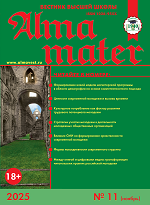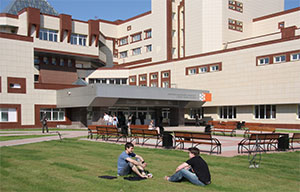UDC 37.09:159.95
https://doi.org/10.20339/AM.02-21.024
N.G. Shilina is Cand.Sci. (Pedagogy), Ass. Prof., Head of Center of additional pre-university education e-mail: shilinang@yandex.ru; L.A. Shapiro is Ass. Prof. at sub-faculty of Medical and biological physic e-mail: liudshapiro@yandex.ru; and V.V. Salmin is Dr.Sci. (Physic & Mathematics), Ass. Prof., Head of sub-faculty of Medical and biological physic e-mail: vsalmin@gmail.com. All at Krasnoyarsk State Medical University n.a. Prof. V.F. Voyno-Yasenetsky
Discussed is effectiveness of specially created enriched (educational) environment impact on memory indicators and learning outcomes of the 1st year students of Krasnoyarsk State Medical University n.a. Prof. V.F. Voino-Yasenetsky in medical and biological physics during classroom training. At the first stage of the study, all students underwent computer testing to determine indicators of general memory and memory of object details recognition, gender differences (MST-version 0.96). At the second stage, results of testing were compared in control groups (n = 32), where classes were held according to the traditional method, and in experimental groups (n = 34), where classes were conducted with elements of the enriched learning environment. The study used the traditional version of MST (Mnemonic Similarity Task), results of the study were processed in the Statistica 6.1 software (StatSoft, Russia). The data distribution was checked for normality using the Shapiro-Wilk test. Test results in two independent groups were compared using the Mann-Whitney test. Frequency analysis was carried out according to Fisher’s exact test (two-sided version). The authors have proven that the use of elements of the enriched learning environment in the classroom improves concentration of students’ attention, increasing the efficiency of separating details of presented objects by 21% and the performance indicators of 41% of students. Obtained average indicators of the share of correct answers (73.4%) and efficiency of separating details of objects (38.4%) correspond to the data obtained in literature for this age category of young people.
Key words: enriched educational environment, learning activities, memory.
References
- Bobyleva, E.A. Influence of external stimuli on human memory and attention. In: Collection of articles of XVII International scientific and practical conference. Moscow: Science and Education, 2019. P. 270–274.
- Maltseva, I.G. Creating a comfortable humanitarian environment in higher education. Concept. 2016. No. 3. P. 21–25. URL: http://e-koncept.ru/2016/16043.htm
- Ясвин В.А. Образовательная среда: от моделирования к проектированию. М.: Смысл, 2001. 365 с.
- Yasvin, V.A. Educational environment: from modeling to design. Moscow: Smysl, 2001. 365 p.
- Stark, S.M., Yassa, M.A., Lacy, J.W., Stark, C.E. A task to assess behavioral pattern separation (BPS) in humans: Data from healthy aging and mild cognitive impairment. Neuro-psychology. 2013. No. 51(12). P. 2442–2449.
- Stark, S.M., Kirwan, C.B., Stark, C.E.L. Mnemonic Similarity Task: A Tool for Assessing Hippocampal Integrity. Trends Cogn Sci. 2019. No. 23 (11). P. 938–951.
- Stark, S.M., Stark, C.E.L. Age-related deficits in the mnemonic similarity task for objects and scenes. Behav Brain Res. 2017. No. 333. P. 109–117.
- Aldi, G.A., Lange, I., Gigli, C., Goossens, L., Schruers, K.R., Cosci, F. Validation of the Mnemonic Similarity Task — Context Version. Braz J Psychiatry. 2018. No. 40 (4). P. 432–440.











.png)






